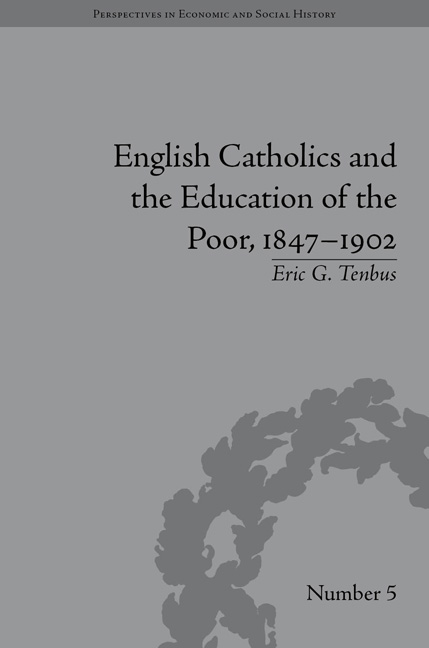22 results
Victorian Christianity and Emigrant Voyages to British Colonies c.1840–c.1914. By Rowan Strong. New York: Oxford University Press, 2018. xiii + 302 pp. $94.00 cloth.
-
- Journal:
- Church History / Volume 88 / Issue 2 / June 2019
- Published online by Cambridge University Press:
- 15 August 2019, pp. 549-551
- Print publication:
- June 2019
-
- Article
- Export citation
Margaret H. Turnham . Catholic Faith and Practice in England 1779–1992: The Role of Revivalism and Renewal. Woodbridge: Boydell Press, 2015. Pp. 222. $115.00 (cloth).
-
- Journal:
- Journal of British Studies / Volume 55 / Issue 4 / October 2016
- Published online by Cambridge University Press:
- 17 October 2016, pp. 861-862
- Print publication:
- October 2016
-
- Article
- Export citation
2 - The Status of Catholic Education at Mid-Century and the Catholic Educational Philosophy
-
- Book:
- English Catholics and the Education of the Poor, 1847–1902
- Published by:
- Pickering & Chatto
- Published online:
- 05 December 2014, pp 13-32
-
- Chapter
- Export citation
4 - English Catholics and the Politics of Education, 1847–70: Preparing for Battle
-
- Book:
- English Catholics and the Education of the Poor, 1847–1902
- Published by:
- Pickering & Chatto
- Published online:
- 05 December 2014, pp 51-70
-
- Chapter
- Export citation
Preface and Acknowledgements
-
- Book:
- English Catholics and the Education of the Poor, 1847–1902
- Published by:
- Pickering & Chatto
- Published online:
- 05 December 2014, pp vii-viii
-
- Chapter
- Export citation
Notes
-
- Book:
- English Catholics and the Education of the Poor, 1847–1902
- Published by:
- Pickering & Chatto
- Published online:
- 05 December 2014, pp 157-190
-
- Chapter
- Export citation
3 - Educational Obstacles to Overcome
-
- Book:
- English Catholics and the Education of the Poor, 1847–1902
- Published by:
- Pickering & Chatto
- Published online:
- 05 December 2014, pp 33-50
-
- Chapter
- Export citation
8 - Catholic Education and Identity after the Balfour Act: The Battle Ends but the Fight Continues
-
- Book:
- English Catholics and the Education of the Poor, 1847–1902
- Published by:
- Pickering & Chatto
- Published online:
- 05 December 2014, pp 149-156
-
- Chapter
- Export citation
1 - A Church Divided and the Educational Solution
-
- Book:
- English Catholics and the Education of the Poor, 1847–1902
- Published by:
- Pickering & Chatto
- Published online:
- 05 December 2014, pp 1-12
-
- Chapter
- Export citation
7 - English Catholics and the Politics of Education, 1891–1902: A Strategy for Success
-
- Book:
- English Catholics and the Education of the Poor, 1847–1902
- Published by:
- Pickering & Chatto
- Published online:
- 05 December 2014, pp 119-148
-
- Chapter
- Export citation
Works Cited
-
- Book:
- English Catholics and the Education of the Poor, 1847–1902
- Published by:
- Pickering & Chatto
- Published online:
- 05 December 2014, pp 191-202
-
- Chapter
- Export citation
CONTENTS
-
- Book:
- English Catholics and the Education of the Poor, 1847–1902
- Published by:
- Pickering & Chatto
- Published online:
- 05 December 2014, pp v-v
-
- Chapter
- Export citation
5 - English Catholics and the Politics of Education, 1870: The Battle Begins
-
- Book:
- English Catholics and the Education of the Poor, 1847–1902
- Published by:
- Pickering & Chatto
- Published online:
- 05 December 2014, pp 71-88
-
- Chapter
- Export citation
Frontmatter
-
- Book:
- English Catholics and the Education of the Poor, 1847–1902
- Published by:
- Pickering & Chatto
- Published online:
- 05 December 2014, pp i-iv
-
- Chapter
- Export citation
6 - English Catholics and the Politics of Education, 1871–90: Engaging With the Enemy
-
- Book:
- English Catholics and the Education of the Poor, 1847–1902
- Published by:
- Pickering & Chatto
- Published online:
- 05 December 2014, pp 89-118
-
- Chapter
- Export citation

English Catholics and the Education of the Poor, 1847–1902
-
- Published by:
- Pickering & Chatto
- Published online:
- 05 December 2014
-
- Book
- Export citation
Dedication
-
- Book:
- English Catholics and the Education of the Poor, 1847–1902
- Published by:
- Pickering & Chatto
- Published online:
- 05 December 2014, pp vi-vi
-
- Chapter
- Export citation
Index
-
- Book:
- English Catholics and the Education of the Poor, 1847–1902
- Published by:
- Pickering & Chatto
- Published online:
- 05 December 2014, pp 203-209
-
- Chapter
- Export citation
‘Bound by the Wrongs We Have Done in the Past’: English Catholics and the Anti-Slavery Movement in Victorian Britain
-
- Journal:
- Recusant History / Volume 31 / Issue 1 / May 2012
- Published online by Cambridge University Press:
- 16 February 2015, pp. 85-98
- Print publication:
- May 2012
-
- Article
- Export citation
Defending the Faith through Education: The Catholic Case for Parental and Civil Rights in Victorian Britain
-
- Journal:
- History of Education Quarterly / Volume 48 / Issue 3 / August 2008
- Published online by Cambridge University Press:
- 24 February 2017, pp. 432-451
- Print publication:
- August 2008
-
- Article
- Export citation



